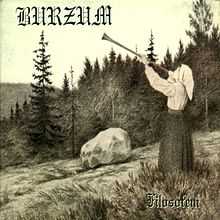Filosofem
| Filosofem | ||||
|---|---|---|---|---|
 | ||||
| Studio album by Burzum | ||||
| Released | 1 January 1996 | |||
| Recorded | March 1993 at Breidablik Studio | |||
| Genre | Black metal, dark ambient, lo-fi | |||
| Length | 64:34 | |||
| Label | Misanthropy, Cymophane | |||
| Producer | Varg Vikernes | |||
| Burzum chronology | ||||
| ||||
| Professional ratings | |
|---|---|
| Review scores | |
| Source | Rating |
| AllMusic | |
Filosofem (Norwegian for "philosopheme") is the fourth studio album by Norwegian black metal solo project Burzum. It was recorded in March 1993 and was the last recording before Varg Vikernes' imprisonment; the album was not released until January 1996, however.
Background
Varg Vikernes recorded the first four Burzum albums between January 1992 and March 1993 at the Grieg Hall in Bergen. However, the releases were spread out, with many months between the recording and the release of each album. During this time, Vikernes became a part of the early Norwegian black metal scene and befriended Mayhem guitarist Euronymous. He also allegedly took part in burning down four churches, along with other members of the scene. In August 1993, Vikernes stabbed Euronymous to death outside his apartment in Oslo. He was arrested a few days later and, in May 1994, was sentenced to 21 years in prison for both the murder and the church arsons.
The opening track on Filosofem, "Burzum", was the first song Vikernes wrote as Burzum. It had been recorded in September 1992 for the Hvis lyset tar oss album, but Vikernes was unhappy with it and re-recorded it for this album six months later.[2] According to a statement made by Vikernes on burzum.org, the master tapes for the version of "Burzum" meant for Hvis lyset tar oss were lost by the Norwegian prison system.
The album was recorded under purposefully bad conditions. No guitar amplifier was used; Vikernes plugged his guitar into the amplifier of his brother's stereo and used an old fuzz pedal.[3] For the vocals, he asked a sound technician for the worst microphone he had, and ended up using a headset.[3]
Music and artwork
The music of Filosofem continued Vikernes' experimentation with minimalism, repetition, and ambient music within black metal. The tracks are all quite long (the shortest being just over seven minutes), and are typically composed around very few musical motifs. For instance, "Jesu død", a track of over eight-and-a-half minutes, is primarily based around variations of a single riff. "Burzum", the opening track, features a prominent melody played by a synthesizer, and the two "Decrepitude" tracks consist of sound effects over very sparse guitars. The album also included Burzum's longest ambient track to date, the 25-minute-long "Rundtgåing av den transcendentale egenhetens støtte".
The album cover and booklet contain artwork by Theodor Kittelsen. The front cover is named Op under Fjeldet toner en Lur (Norwegian for "up under the mountains a clarion call rings out").
Track listing
All songs written and composed by Varg Vikernes.| No. | Title | German version | Length | |
|---|---|---|---|---|
| 1. | "Burzum" ("Darkness") | "Dunkelheit" | 7:05 | |
| 2. | "Jesu død" ("Jesus' Death") | "Jesus' Tod" | 8:39 | |
| 3. | "Beholding the Daughters of the Firmament" | "Erblicket die Töchter des Firmaments" | 7:53 | |
| 4. | "Decrepitude I" | "Gebrechlichkeit I" | 7:53 | |
| 5. | "Rundtgåing av den transcendentale egenhetens støtte" ("Tour Around the Transcendental Columns of Singularity") | "Rundgang um die transzendentale Säule der Singularität" | 25:11 | |
| 6. | "Decrepitude II" | "Gebrechlichkeit II" | 7:53 |
Personnel
References
- ↑ Rivadavia, Eduardo. "Filosofem - Burzum : Songs, Reviews, Credits, Awards : AllMusic". AllMusic. Retrieved 12 August 2012.
- ↑ Mitchell, Chris (10 May 2005). "The Metal Crypt - Varg Vikernes Interview". metalcrypt.com. Archived from the original on 1 March 2009. Retrieved 12 August 2012.
- ↑ 3.0 3.1 Vikernes, Varg (July 2005). "Varg Vikernes - A Burzum Story: Part VI - The Music". burzum.org. Retrieved 12 August 2012.
External links
| |||||||||||||||||